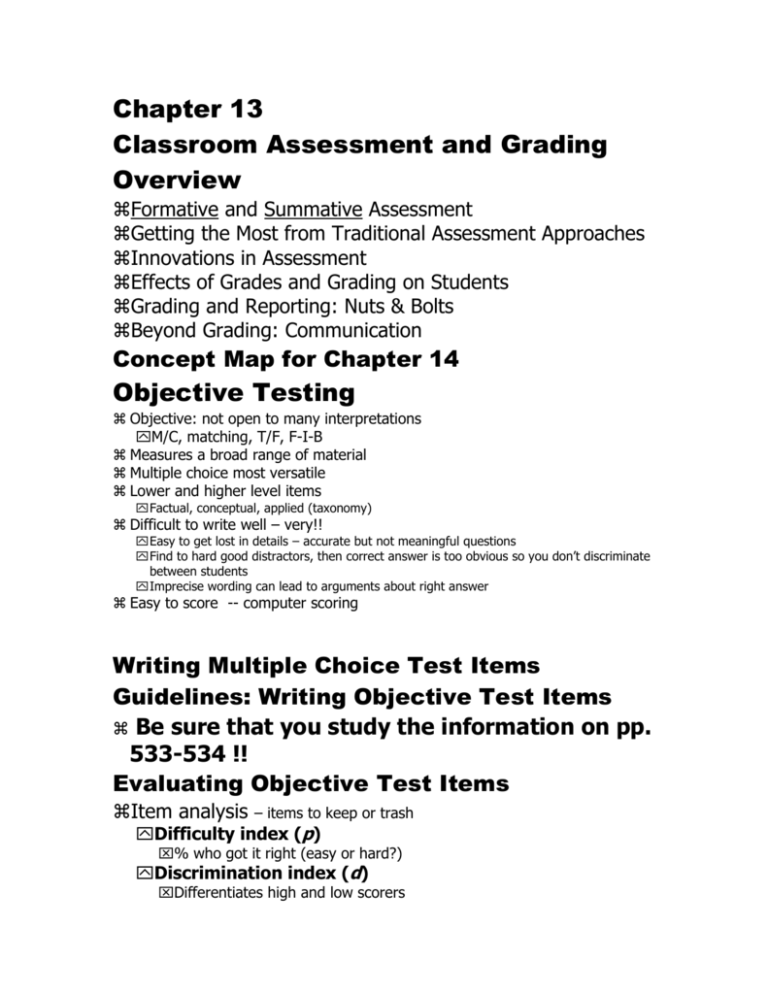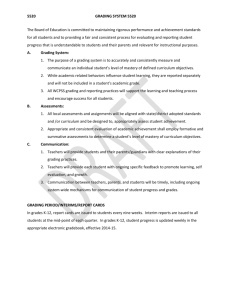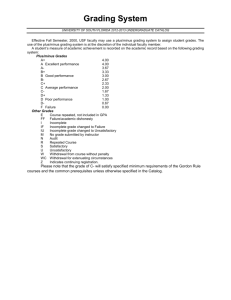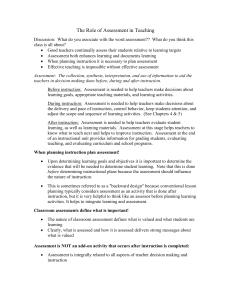Chapter 13 Classroom Assessment and Grading
advertisement

Chapter 13 Classroom Assessment and Grading Overview Formative and Summative Assessment Getting the Most from Traditional Assessment Approaches Innovations in Assessment Effects of Grades and Grading on Students Grading and Reporting: Nuts & Bolts Beyond Grading: Communication Concept Map for Chapter 14 Objective Testing Objective: not open to many interpretations M/C, matching, T/F, F-I-B Measures a broad range of material Multiple choice most versatile Lower and higher level items Factual, conceptual, applied (taxonomy) Difficult to write well – very!! Easy to get lost in details – accurate but not meaningful questions Find to hard good distractors, then correct answer is too obvious so you don’t discriminate between students Imprecise wording can lead to arguments about right answer Easy to score -- computer scoring Writing Multiple Choice Test Items Guidelines: Writing Objective Test Items Be sure that you study the information on pp. 533-534 !! Evaluating Objective Test Items Item analysis – items to keep or trash Difficulty index (p) % who got it right (easy or hard?) Discrimination index (d) Differentiates high and low scorers • The item should be passed more by the higher scorers Essay Testing Requires students to create an answer May be the only way to test an objective Most difficult part is judging quality of answers subjective Writing good, clear questions can be challenging Easily misunderstood if not carefully written Constructing Essay Tests Essay tests focus on less material - time Require a clear and precise task Define overextension and underextension in language use and explain when and why children use each. Describe how a parent of higher IQ children is likely to treat the children. Should measure an objective at Bloom’s Synthesis (Creating) level Allow ample time for students to answer May combine with objective questions to increase scope of exam Evaluating Essays: Dangers Problems with subjective testing Individual standards of the grader Neatness, grammar, spelling… Big deal or not a big deal? Unreliability of scoring procedures Ranges too broad (reliable means?) Bias: wordy essays often get more points Tell me about Starch & Elliot’s studies (p.536) Evaluating Essays: Methods (Phil Winne•fs – p.536-537) Construct a model answer Give points for each part of the answer (key and supplemental) Give points for organization Compare answers on papers that you gave comparable grades Time Consuming but good Evaluating Essays: Methods (Gronlund – p.537) Grade all responses to one question, then all responses to second question, etc. Shuffle the papers between questions Have students put their names on the back of the paper Have another teacher in your discipline read some of your graded essays (LAB 1) Authentic Assessments – Innovations in Assessment Authentic classroom tests Students apply skills and abilities as they would in the real life “…test those capabilities and habits we think are essential, and test them in context.” (Wiggins) Like the idea of a driving test – can you really “drive” the car? Performance in context (not enough to know just the facts; can be a portrait of the student over time) portfolios (purposeful collection of works) exhibitions (public performance & exhibition of mastery) Evaluating Portfolios and Performances Checklists Rating scales Scoring rubrics or general descriptions Students can participate in the development of such evaluation tools Improves work and learning…why? Issues of reliability, validity, generalizability, and equity. *Criterion-referenced Effects of Grading Need a balance between standards and success. Effects of failure Some failure is good (learn to fail successfully) Failing an entire grade (promote & remediate, p. 547) See supplemental material on course website. Effects of feedback – knowing ‘why’ they were wrong Good to know why you are wrong; specifics Gear feedback to age of student; balance the good & the bad Effects of grades on motivation Working for a grade or to learn? Simple level but detailed = working for a grade Low grades may lead to decreased motivation Grading and Reporting: Nuts and Bolts Criterion-Referenced – quality of the individual accomplishment Mastery of objectives Criteria for grades set in advance Student determines what grade they want to receive All students could receive an “A” Not comparison grading * Figure 14.4, p.550 Norm-Referenced Grading LAB 2 Grading on the curve Students compared to other students “Average” becomes the anchor for other grades (bracket the middle 2/3 scores) Fairness issues E.g., across sections “Adjusting” the curve Parent/Teacher Conferences Plan ahead Start positive Use active listening and problem solving Don’t just go on the defensive if parents are angry or upset – LISTEN!!! Establish a partnership Plan follow-up contacts Tell the truth! Be prepared with samples End on a positive note






